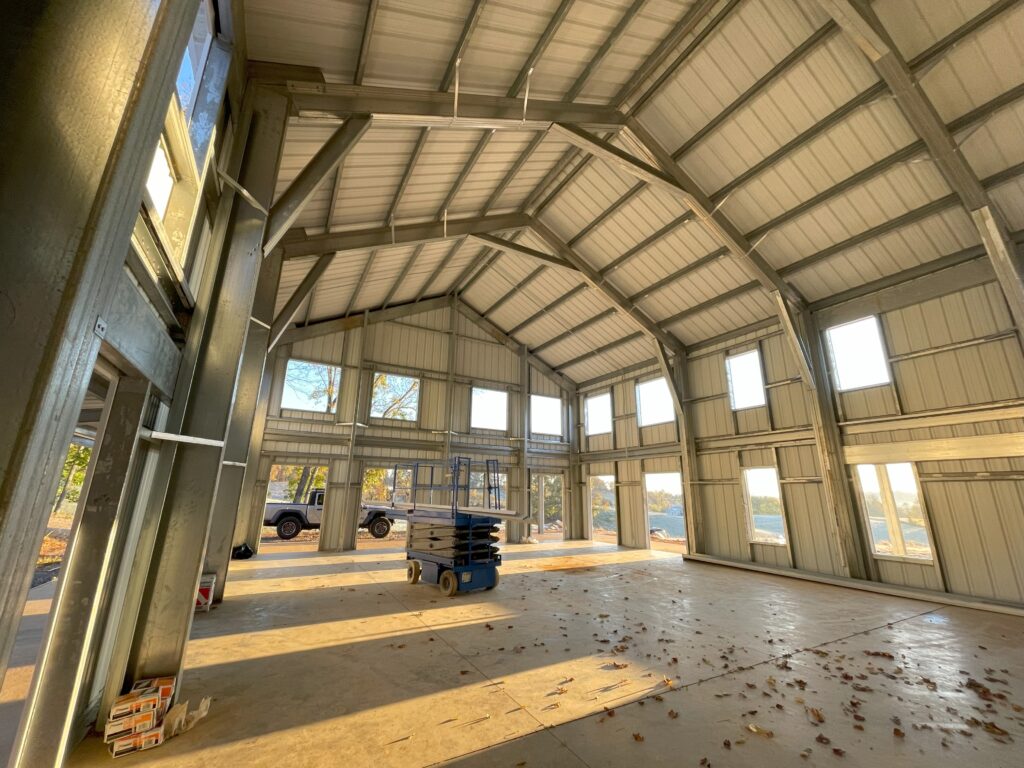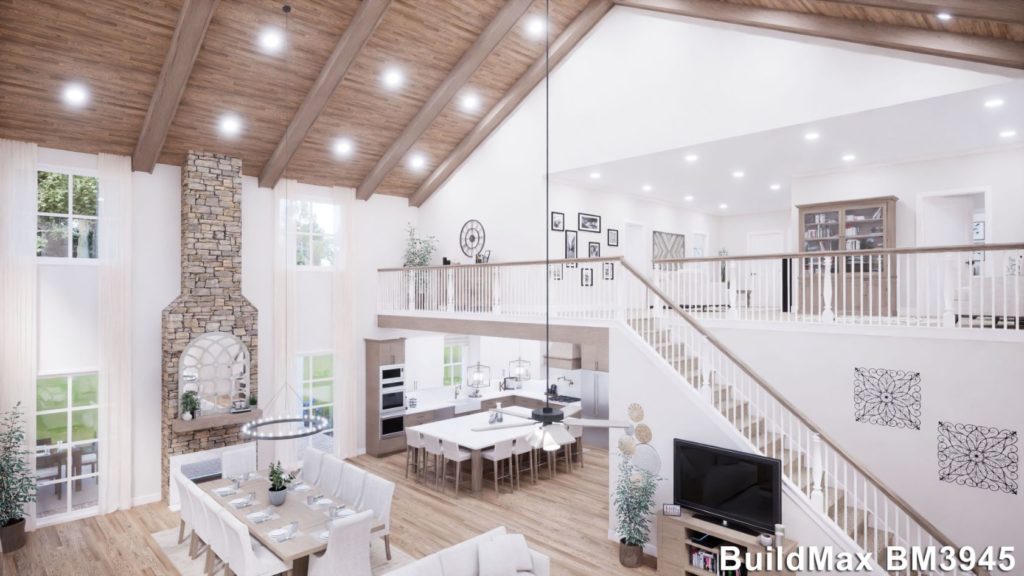With colder months on the horizon, you may be wondering if barndominiums hold up in cold weather. While barndominiums are often associated with warmer climates, it’s entirely possible to design one suitable for cooler areas. However, it’s crucial to account for several factors to ensure your structure is warm, cozy, and durable. Keep reading for some key considerations when erecting a barndominium in cold climates and how to heat your barndo.
Benefits of Barndominiums in Cold Climates: A Closer Look at Steel Construction
Barndominiums, commonly known for their spacious frames and open floor layouts, stand out from traditional homes due to their distinct construction techniques. While conventional houses rely on wood stud framing, barndominiums are often constructed using pole framing or post-frame methods. More recently, barndominiums have shifted towards steel frames, offering several advantages over wood, particularly in colder regions.
Here are some reasons why steel-framed barndominiums are an excellent choice in cold climates:
- Superior Thermal Conductivity: Steel is better at conducting heat compared to wood, meaning it can efficiently transfer warmth into the interior of a barndominium. This feature can be capitalized upon in cold climates by designing the structure to capture sunlight and heat up the interior.
- Enhanced Snow Load Support: In areas prone to heavy snowfall, the weight of accumulated snow can strain and damage the roofs of traditional homes. Barndominiums constructed with steel frames, however, are more resilient and capable of supporting increased snow loads, reducing the risk of roof-related problems.
- Reduced Seasonal Shifting and Settling: Steel-framed barndominiums are less prone to shifting and settling compared to their wood-frame counterparts. Wood retains moisture, leading to expansion during warmer periods and contraction in cold weather, causing the frame to shift and settle over time. This can result in cosmetic issues like drywall cracks, and in more severe cases, foundation problems. By choosing a steel-framed barndominium, homeowners can minimize these issues and enjoy a more stable living space.
In summary, steel-framed barndominiums offer a slew of benefits for those living in cold climates, from efficient heat transfer and increased snow load support to reduced shifting and settling. The unique construction methods used in these homes make them a more durable and low-maintenance option, ideal for colder regions.
Optimize Your Barndominium for Cold Climates with Sunlight and Insulation
Constructing a barndominium in a sunny area offers several benefits for those living in cold climates. Due to the high thermal conductivity of steel, metal buildings can absorb and harness more energy from the sun’s UV rays than their wooden counterparts. Taking advantage of this feature will lead to more efficient heating inside your barndominium.
Locating your barndominium in an area with abundant sunshine ensures that it will benefit from solar heat throughout the year. During winter months, the sunlight reflecting off the snow can provide an additional source of warmth. Furthermore, selecting certain building materials can enhance this heat transfer effect. Siding and roofing made from copper or aluminum can effectively transfer more heat into your barndominium.
Proper insulation is crucial for maintaining a comfortable temperature within your barndominium, particularly if it has a metal frame. Metal, while being an excellent conductor of heat, is not an effective insulator. Although metal siding and roofing can quickly heat up, the addition of insulation is necessary to retain this warmth inside the building.
Even if your barndominium has a wood frame, it is still advisable to use extra insulation. High-quality insulation in the wall cavities can protect the wood posts from moisture and enhance temperature control. Consider using a combination of insulation options, such as radiant barrier insulation and spray foam insulation, to maximize their effectiveness.
Radiant barrier insulation is highly reflective and redirects more heat into your barndominium, making it easier to maintain a warmer interior. On the other hand, spray foam insulation is commonly used inside wall cavities because it offers more comprehensive coverage than other insulation materials. As it is sprayed into the walls and expands, it fills every crack and crevice, reducing the likelihood of moisture accumulation.
In summary, taking advantage of sunlight and proper insulation is key to optimizing your barndominium for cold climates. By selecting suitable building materials and insulation options, you can ensure that your barndominium stays warm and comfortable throughout the winter months.
Maximize Heating Efficiency in Your Barndominium with Open Floor Plans, Ceiling Fans, and Sealing Techniques
Adopting an open floor plan is an excellent way to enhance heating efficiency in a barndominium. In a rectangular building, splitting the space into multiple rooms and hallways makes temperature control more challenging. However, barndominiums typically feature large open spaces that make it easier to maintain temperatures. In an open floor plan, multiple living areas are merged into one spacious area without the separation of walls and doorways. This layout allows air to flow freely, increasing the efficiency of your heating system.
Incorporating ceiling fans in your barndominium design can also help with heating efficiency, particularly if your space features tall, vaulted ceilings, lofts, or mezzanine areas. As warm air rises, it can become trapped near the ceiling, leaving the living areas below cooler. By installing ceiling fans set to spin clockwise at a low speed, you can create an updraft that pulls cool air upward while pushing the warm air down along the walls, effectively redistributing the heat throughout the space.
While a steel frame and proper insulation are essential for maintaining warmth in your barndominium, sealing the exterior is equally important to prevent air leaks. Even a small air leak can significantly affect the heating efficiency of your space, leading to temperature differences and drafts. To avoid this, ensure that windows and door frames are sealed properly. Additionally, pay attention to the eaves, corners, and base panels of your barndominium, applying caulk to any areas where air could potentially pass between the interior and exterior.
In summary, optimizing heating efficiency in your barndominium can be achieved by implementing an open floor plan, using ceiling fans to redistribute warm air, and sealing the exterior to prevent air leaks. These measures will help you create a comfortable living space that stays warm even in colder climates.
Exploring Radiant Heat Flooring for Your Barndominium in Cold Climates
Radiant heat flooring is a valuable and cost-effective option for heating your barndominium, especially in colder climates. This system relies on radiant heat transfer to warm up your living spaces, providing a comfortable environment throughout the cold months. Instead of relying on traditional ducts to distribute warm air, radiant heat flooring directly heats the floor, which in turn warms the walls, furniture, rugs, and occupants of the space.
One of the advantages of radiant flooring is that it can be installed directly in a slab foundation, removing the need for a crawl space to accommodate ductwork for a conventional furnace. Moreover, radiant flooring is a suitable option for barndominiums with tall ceilings, a common architectural feature of these buildings. The system concentrates heat near the floor, where it is needed most, minimizing heat loss to the ceiling.
While the initial installation costs of radiant flooring may be higher compared to traditional heating systems, the long-term benefits are worth considering. Radiant flooring is more cost-efficient, providing an even distribution of heat throughout the living space and reducing energy bills over time.
Conclusion: Are Barndominiums a Viable Option in Cold Climates?
Absolutely! Barndominiums offer several advantages when it comes to thermal conductivity, allowing your home to absorb more heat from the sun’s rays. This unique design feature helps mitigate common issues like drywall cracks and other damage associated with seasonal settling and shifting.
However, it is essential to prepare your barndominium to ensure it remains warm and comfortable throughout the cold months. Adequate insulation is crucial, with spray foam offering superior coverage and insulation values compared to other options. Consider installing radiant flooring for efficient heating and positioning your barndominium in a sunlit area to maximize the benefits of solar heating.
Ultimately, barndominiums are well-suited for cold climates, often providing more energy-efficient housing compared to traditional homes. By implementing the right measures, you can enjoy a comfortable and cozy living space, even in the harshest winter conditions.













